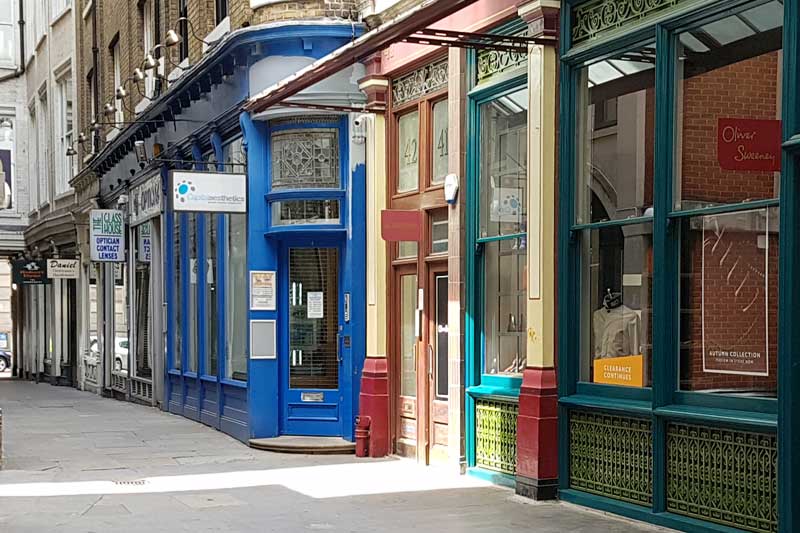
A WARM WELCOME
Greetings my none wizard friends. I am The Magician, and for the next few hours I will be guiding you on a journey around the London locations that have featured in the Harry Potter films and books.
You'll be visiting some wonderful places - the Leaky Cauldron, Diagon Alley and an ancient magical emporium, to name but a few - but you'll also have to dodge a few Death Eaters that may, at any moment, come swooping down from above!
You'll also meet a few dragons, as well as one or two other fantastic beasts, since I can show you where to find them in London!
But fear not, for, although you cannot see me (I have, after all, donned my cloak of invisibility), I am standing there beside you, and I will ensure that you don't take a wrong turn and end up in Knockturn Alley, or some similar place of ill-repute.
I'll also show you some places that, so I understand, you Muggles like to see when you visit London, such as Big Ben, St Paul's Cathedral, Westminster Abbey and Downing Street.
I would say that you are in for an intriguing time.
So, my Muggle friends, whenever you are ready, let us set off on our magical journey around London.
Have your wands ready!
LEAKY CAULDRON HERE WE COME!
To begin your Harry Potter tour, make your way to Exit Three of Bank Underground Station.
This is situated directly in front of the Royal Exchange. If you have difficulty locating this Exit, just go down into Bank Underground Station and follow the signs for Exit Three.
If you are travelling to Bank on the Northern Line, be sure to follow the signs on the platform for the Bank of England Exit.
DIRECTIONS
Turn right out of Exit Three of Bank Underground Station, and walk towards the statue of the man in the hat in the centre of Cornhill. He is:-
JAMES HENRY GREATHEAD (1844 - 1896)
Although you might not instantly know his name, you most certainly are familiar with his most famous invention, as there's a good chance you have just benefited from it.
He was the inventor of the ";Greathead Shield" - also known as the "Travelling Shield" - a one piece, circular tunneling device that made possible the excavation of the deep level underground tunnels which enable use to be whisked, deep beneath the streets, from one end of London to another in the blink of an eye.
As Mr. Weasley put it, in Harry Potter And The Order Of The Phoenix "trains that travel underground, ingenious these Muggles!"
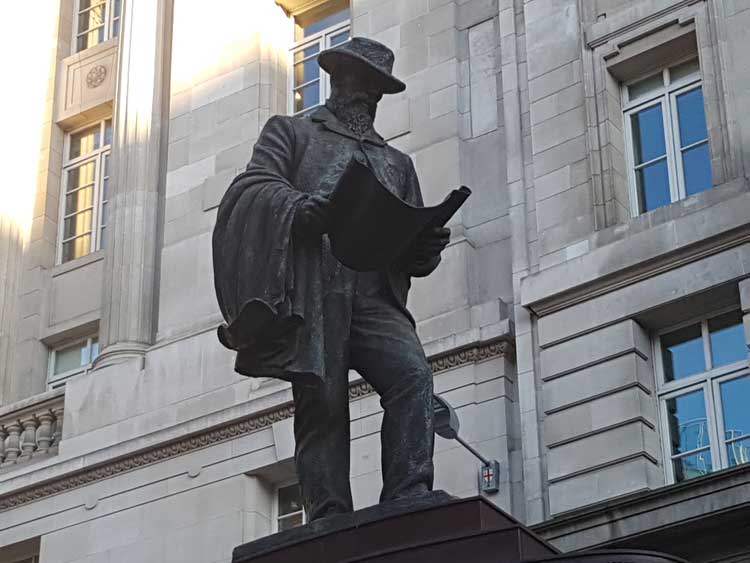
The J. H. Greathead Statue on Cornhill.
DIRECTIONS
As you face the statue, go left along Cornhill, pass under the clock, and walk until, at the side of the road on your right, you reach the traffic light pedestrian crossing. Use it to cross Cornhill and turn left on the other side.
Turn next right along Birchin Lane, and second left into the very narrow, easily missed Bengal Court. This could, so easily, be an entrance to Diagon Alley or some other magical location, but, if you keep ahead and squeeze into the covered passage, on your left you will find-
THE GEORGE AND VULTURE - A DICKENSIAN LOCATION
The alleyway you arrive in is extremely atmospheric; even the London traffic and everyday bustle are strangely muffled.
It was in this part of the City that Charles Dickens placed the office of Ebenezer Scrooge in A Christmas Carol, and, it has to be said, that the alleyways hereabouts still have a very Dickensian feel.
The neighbourhood has changed much since, but here in this backwater of grimy alleyways time stands still, and you can picture its Victorian residents, "going wheezing up and down, beating their hands on their breasts, and stamping their feet upon the pavement stones to warm them".
If you look into the window of the George and Vulture on the left, just before the white brick arch, you will even see a white marble bust of Charles Dickens, looking inwards on a restaurant that can have changed little since his living self used to dine here.
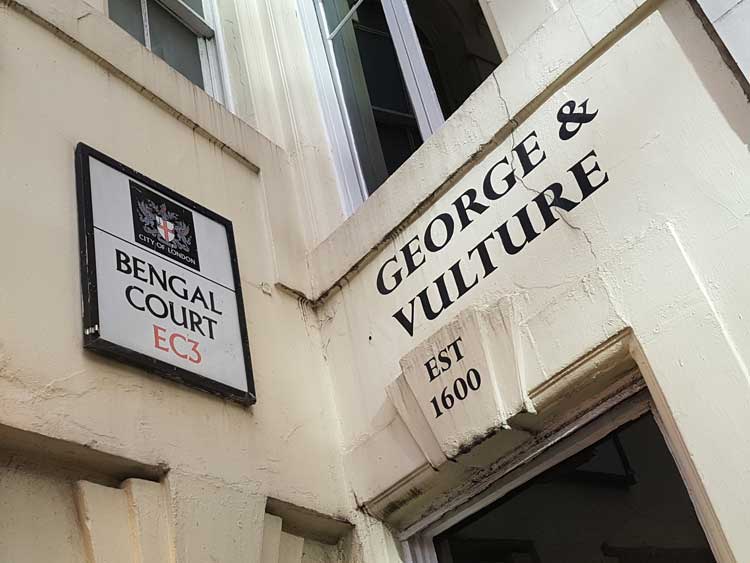
The George And Vulture.
DIRECTIONS
Continue through the passage, and go left into St Michael's Alley, passing on the left the main entrance to the George and Vulture.
Keep ahead, passing the Jamaica Wine House, notice the plaque on its wall marking the site of London's first coffee house, and turn right along Cornhill.
Keep walking until, on the right, you come to the door of the church of:-
ST PETER UPON CORNHILL
The red-brick building to the right of the church is surmounted by three ferocious looking demons.
Indeed, why not see if the children can spot them?
The devils crouch as though poised to leap from their perches and wreak demonic mayhem around the church.
They are said to remember a bitter feud between a long ago vicar of St Peter's and the architect who designed this building, Ernest Augustus Runtz. When Runtz drew up his original plans for the building he did it in such a way that his new building would have encroached on land owned by the church.
As it happened, the then vicar of St Peter's was very territorial, and he created such a furore that the architect was forced to redesign the building, which cost him a great deal of both time and money.
When the building was finally completed, Runtz added the grotesques in commemoration of the feud and, it is said, modelled the face of the fiercest demon on that of his arch enemy, the then vicar of St Peter's.
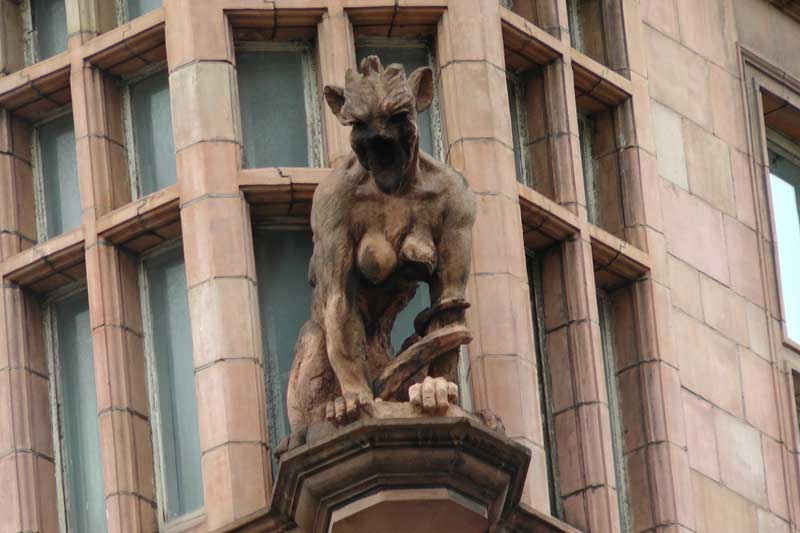
A Cornhill Devil.
DIRECTIONS
Keep ahead along Cornhill and cross straight over the traffic light. Turn right on the other side, and then go left into Leadenhall Market, just before the New Moon Pub.
LEADENHALL MARKET - CHARING CROSS ROAD
In Harry Potter And The Philosopher's (Sorcerer's) Stone, Leadenhall Market was used as Charing Cross Road, along which Harry and Hagrid make their way en route to the Leaky Cauldron to purchase the items Harry requires for Hogwarts School of Witchcraft and Wizardry.
The market, which dates from 1881, is London's most beautiful Victorian market.
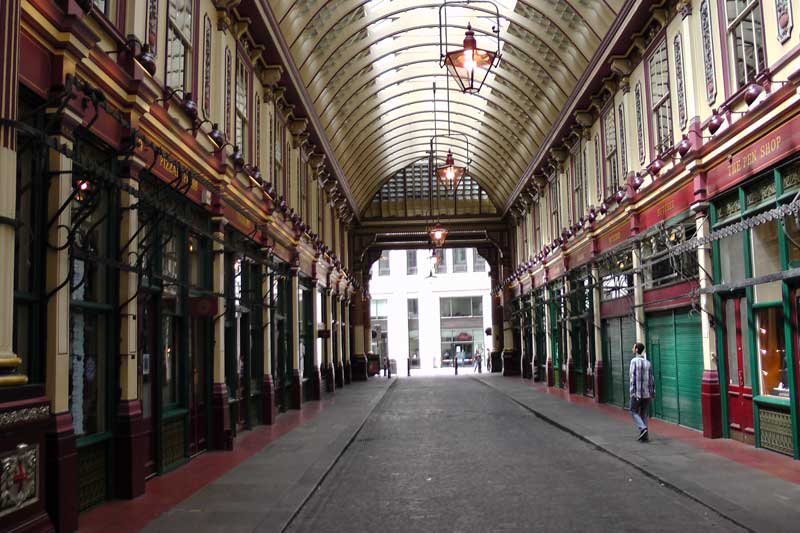
Leadenhall Market - Charing Cross Road In Harry Potter.
DIRECTIONS
Keep ahead to the centre of the market, and turn right, just before the Lamb Pub on the left.
Take the second turning on the right and pause outside the blue door of the optician's shop on the right:-
THE ENTRANCE TO THE LEAKY CAUDLRON®
In Harry Potter And The Philosopher's (Sorcerer's) Stone, the door you are looking at was the entrance that Harry and Hagrid used to enter the Leaky Cauldron.
The exterior of the shop was painted black for its starring role, and the shop's windows were boarded over, no doubt to keep the prying eyes of curious Muggles from looking in.
The sign which hangs over the door - and which was, in fact, a prop, specially attached for the filming - is completely black as Harry and Hagrid walk towards it. But, when they arrive at the door, it magically reveals the name "The Leaky Cauldron."

The entrance to the Leaky Cauldron.
WATCH THE SCENE
You can watch the scene as they enter the Leaky Cauldron in the first clip on this video:-
WHY THE NAME CHANGE?
You may have noticed that the film had two titles - Harry Potter And The Philosopher's Stone and Harry Potter and the Sorcerer's Stone.
When Jo Rowling (as she liked to be known) wrote the first book it was published in England as "The Philosopher's Stone."
However, when, in April, 1997, Scholastic Corporation purchased the American rights for the book - paying the, at the time, astronomical sum for a children's book of £105,000 - they were worried that children would not be interested in a book that had the word "philosopher" in the title and, as a result, the American edition appeared in September, 1998, under an alternative title, which was suggested by J. K. Rowling, Harry Potter and the Sorcerer's Stone.